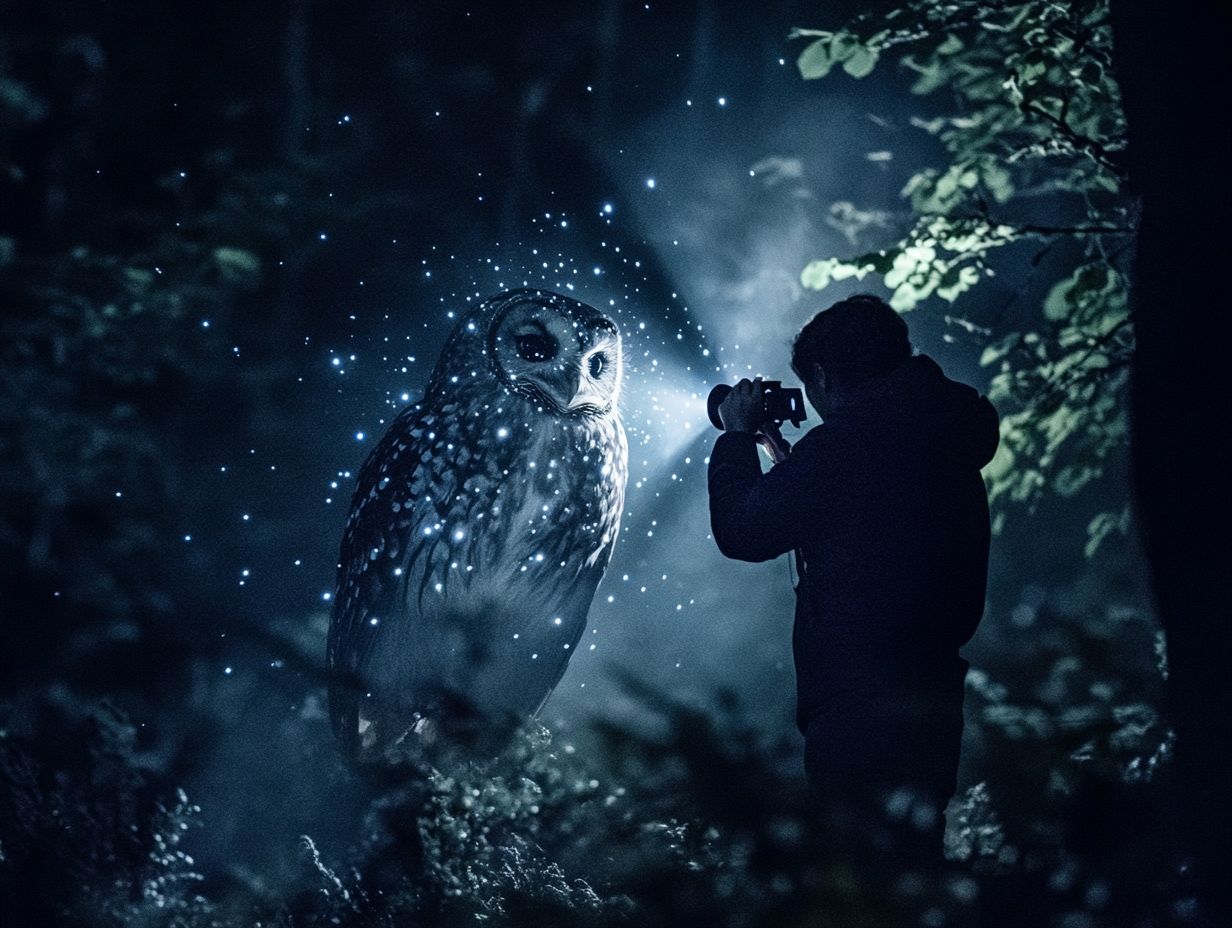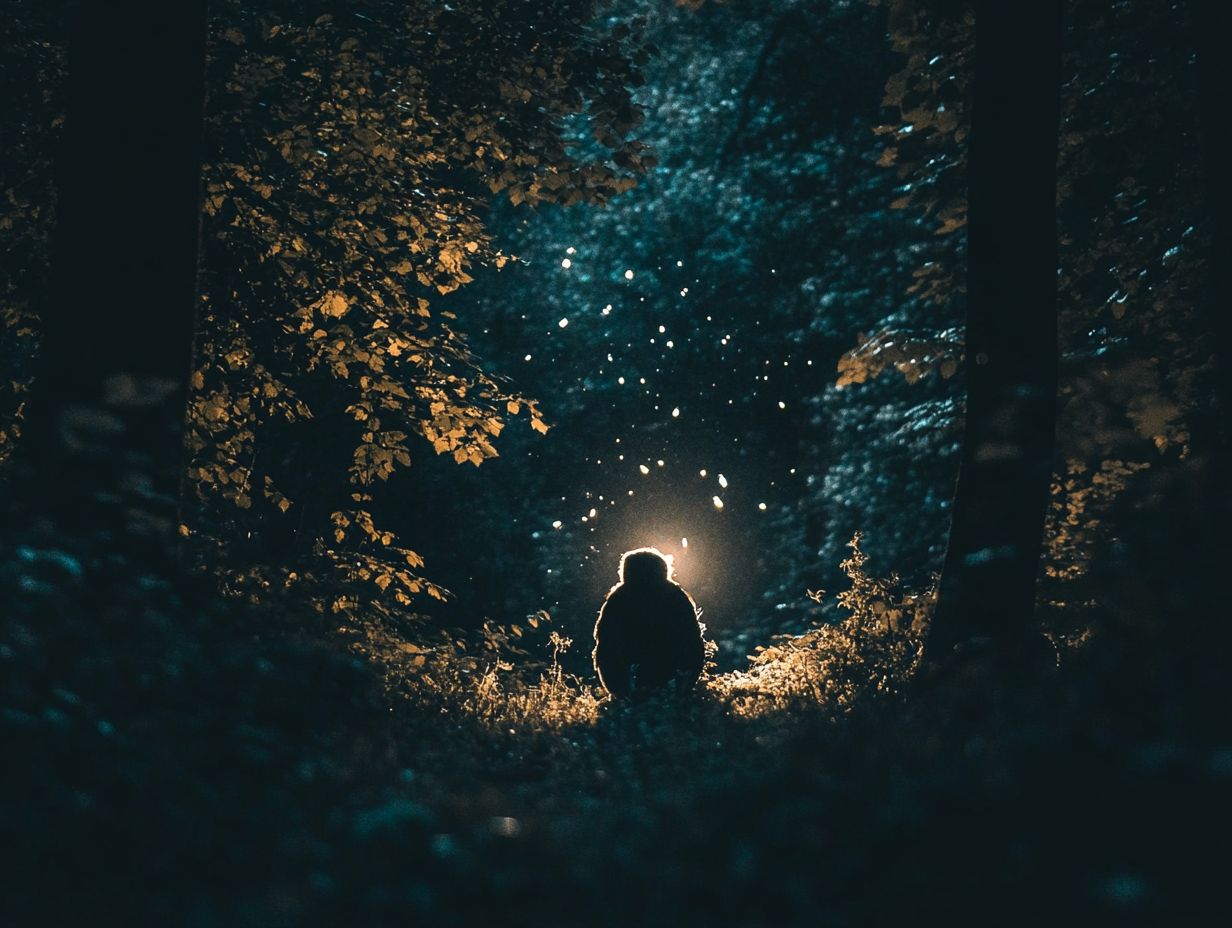Techniques for Nighttime Bird Photography
Photographing birds at night presents unique challenges. These challenges can frustrate or inspire you as a photographer.
With the right gear and techniques, you can capture stunning images of these elusive creatures. This can turn into an exhilarating adventure.
This guide provides essential equipment recommendations, optimal settings, and creative methods to elevate your nighttime photography.
From selecting the perfect locations to mastering long exposure (a technique to capture more light over time), you’ll discover practical tips designed to enhance your skills and maximize your night shoots. Get ready to explore the enchanting world of nocturnal birdlife!
Contents
- Key Takeaways:
- Essential Equipment for Nighttime Bird Photography
- Setting Up for Nighttime Bird Photography
- Techniques for Capturing Quality Nighttime Bird Photos
- Tips for Improving Your Nighttime Bird Photography
- Frequently Asked Questions
- What is nighttime bird photography?
- What are some techniques for capturing nighttime bird photos?
- What equipment is needed for nighttime bird photography?
- How should I prepare for a nighttime bird photography session?
- What are some challenges of nighttime bird photography?
- What are some tips for getting the best nighttime bird photos?
Key Takeaways:

Why Photographing Birds at Night is Challenging
Photographing birds at night requires more than just advanced camera settings; it demands an understanding of wildlife behavior and the distinct traits of nocturnal creatures. Capturing stunning wildlife photos in darkness needs a careful approach to photo composition and the ability to adapt swiftly to ever-changing environments and lighting conditions, which can vary greatly from the bright light of day.
The dance of light, movement, and emotion can create captivating images that tell a story. However, mastering this art often requires a careful approach.
Navigating nighttime settings can be daunting. Low-light photography pushes you to increase ISO settings (which help your camera work better in low light), which can lead to grainy images if not managed with precision. Understanding the behaviors of bird species that venture out under the moonlight adds another layer of complexity to this intricate craft.
Observing how these creatures interact with their surroundings be it hunting, foraging, or resting provides valuable insights into how to frame your shots. Crafting compelling compositions is essential, as every angle and shadow plays a crucial role in conveying the scene’s mood, truly showcasing the beauty and mystery of nocturnal wildlife.
Essential Equipment for Nighttime Bird Photography
To effectively capture stunning nighttime bird photos, having the right equipment is paramount. You’ll want a high-quality camera that excels in low-light conditions, along with specialized lenses tailored for wildlife photography. Exploring the best bird photography techniques for 2024 can also enhance your skills and results.
A robust tripod is also crucial, ensuring stability during longer exposures. Consider innovative tools like the MIOPS Smart Camera Trigger, which can elevate your shooting experience by offering creative options for triggering your camera when faced with challenging lighting scenarios.
Camera Gear and Accessories
When you re gearing up for nighttime bird photography, choosing the right camera gear and accessories is essential. Think about settings that will thrive in low-light conditions, select lenses that align with the specific wildlife you re eager to capture, and ensure that your tripod is stable enough to deliver crisp, clear images.
To seize breathtaking shots of nocturnal birds, a camera with strong ISO performance will serve you well, enhancing your sensitivity to light while keeping noise at bay.
Opting for a fast lens with a wide aperture think f/2.8 or wider will let in more light, which is invaluable when you re working in those dim conditions.
Don t overlook the importance of focal lengths either. A longer lens allows you to get closer to your subjects without disturbing them, preserving their natural behavior. A sturdy tripod is a must-have. It minimizes camera shake during longer exposures, significantly enhancing the sharpness and overall quality of your photos.
Setting Up for Nighttime Bird Photography
When preparing for nighttime bird photography, you’ll want to follow several essential steps.
- First, adjust your camera settings to optimize exposure compensation; this is vital for capturing clear images in low-light conditions.
- A keen understanding of wildlife behavior is crucial.
- By anticipating the movements and actions of nocturnal animals, you greatly increase your chances of capturing breathtaking photographs.
Choosing the Right Location and Time

Choosing the right location and time for nighttime bird photography is essential. It can make or break the quality of your wildlife photos. Select areas rich in wildlife activity and captivating nighttime landscapes, and you’ll be rewarded with breathtaking results.
Understanding the habits and movements of birds during those magical twilight hours will significantly boost your chances of capturing stunning images. When you observe which species are most active at night, you can pinpoint the optimal spots for your photographic adventure.
Ideal settings often include wetlands or coastal areas teeming with nocturnal activity. Pay attention to low-light conditions. Using the right shutter speed can help you avoid motion blur while still capturing exquisite detail.
By aligning your expectations with wildlife behaviors and leveraging natural light cues, you can turn your nighttime excursions into unforgettable photographic experiences.
Adjusting Camera Settings for Low Light
Adjusting your camera settings for low light is crucial in nighttime bird photography. Optimizing ISO, aperture, and shutter speed can dramatically influence the quality of your images and help you minimize challenges like noise and motion blur.
Finding the perfect balance among these three vital components is key to capturing breathtaking images in such demanding conditions. For example, while raising the ISO enhances the sensor’s sensitivity to light, it may also introduce unwanted noise that compromises the overall quality of your photograph.
Choosing a wider aperture allows more light to flood into the lens, enabling faster shutter speeds that can freeze motion and reduce blur. Selecting the right shutter speed is essential; it must be quick enough to counteract any movement from the subject or even your own camera shake.
Using techniques like bracketing exposures and post-processing noise reduction can further elevate your image clarity, ensuring that the beauty of the scene is captured in all its glory.
Techniques for Capturing Quality Nighttime Bird Photos
Capturing stunning nighttime bird photos demands mastering particular techniques, such as flash photography and the effective use of artificial light. For those looking to enhance their skills, knowing the best time of day for bird photography can also greatly improve your results. By employing these methods, you can beautifully illuminate your subjects while minimizing any disturbance to wildlife.
As you engage in these shooting techniques, remain mindful that overusing flash can startle birds, disrupting their natural behaviors and possibly driving them away from their preferred habitats. Opting for the right camera settings like lower ISO values to minimize noise and slower shutter speeds for optimal light capture can help you navigate these challenges effectively.
Using Flash and Artificial Lighting
Using flash and artificial lighting for nighttime bird photography can yield stunning, dramatic effects. It’s essential to grasp how these elements interact with wildlife behavior and adjust your camera settings accordingly to achieve the perfect exposure compensation.
Employing methods such as bounce flash or diffusers can soften the light, rendering it less intrusive to the animals. By understanding these facets, you not only enhance the quality of your images but also foster a more ethical approach to wildlife photography.
Now that you re equipped with these tips, grab your camera and head out for an unforgettable nighttime adventure!
Long Exposure Techniques
Long exposure techniques are your secret weapon in nighttime bird photography. They allow you to capture breathtaking images. By relying on a sturdy tripod and precise shutter speed settings, you guarantee clarity and detail even in low-light conditions. For more tips, check out understanding exposure for bird photography.
When you use a tripod, you significantly reduce camera shake. This is essential for achieving those sharp images in dimly lit environments. The stability of a good tripod lets you extend your exposure times without sacrificing picture quality.
Adjusting your shutter speed is crucial for balancing light capture. This gives you the ability to freeze motion amidst the twilight or darkness. This approach enhances the beauty of your avian subjects and reveals their habitats in a way that ordinary snapshots can’t match.
Tips for Improving Your Nighttime Bird Photography

To elevate your nighttime bird photography, you need to strike a good mix between thoughtful composition and your inherent creativity. You also need practical strategies for managing noise and grain. These elements can significantly diminish the quality of your wildlife captures.
Composition and Creativity
Effective photo composition is essential in wildlife photography, particularly in low-light conditions. By employing creative techniques, you can elevate your images and evoke emotions that resonate with your viewers.
When you capture the elusive beauty of nocturnal creatures, pay close attention to elements like framing, balance, and the rule of thirds. Incorporating techniques such as leading lines guides the viewer s eye through the scene. Strategically using negative space instills a sense of solitude that reflects the tranquility of the night.
Creative use of light whether from moonlight or artificial sources can reveal textures and details that might vanish into the darkness. Ultimately, fostering a sense of wonder and intrigue in each shot transforms a simple wildlife encounter into a captivating visual narrative.
Dealing with Noise and Grain
Dealing with noise and grain in low-light photography can be a fun puzzle to solve. This is particularly true when you’re aiming for high image quality in nighttime bird photography. Mastering effective noise reduction techniques is essential for achieving crisp, clear shots.
Understanding the impact of your ISO settings is critical. Increasing the ISO enhances sensitivity to light, but it can also introduce unwanted noise. Your goal should be to find that perfect balance. Typically, lower ISO values combined with longer exposure times work wonders, minimizing grain.
Employing a stabilizing tripod significantly enhances image clarity. It prevents any motion blur that could compromise your shot. Don t underestimate the power of post-processing software; it offers robust tools for reducing noise and sharpening images, ensuring stunning nighttime moments are preserved in all their glory.
Frequently Asked Questions
What is nighttime bird photography?
Nighttime bird photography is the practice of taking photographs of birds during the hours of darkness. This typically occurs when the sun has set and ambient light levels are low.
What are some techniques for capturing nighttime bird photos?

Some techniques for nighttime bird photography include using a flash, setting up a camera trap, and utilizing techniques for photographing birds in flight with long exposure times.
What equipment is needed for nighttime bird photography?
To capture quality nighttime bird photos, you will need a DSLR or mirrorless camera with a long lens, a tripod, a remote shutter release, and a flashlight for focusing in the dark.
How should I prepare for a nighttime bird photography session?
Before heading out to photograph birds at night, it’s important to scout the location during the day. Charge your camera batteries and dress appropriately for the weather.
Grab your camera and start exploring the nighttime beauty of birds now!
What are some challenges of nighttime bird photography?
Nighttime bird photography presents unique challenges. You’ll face low light conditions, difficulty focusing, and the risk of motion blur when capturing birds. To overcome these obstacles, check out these tips for photographing rare bird species.
What are some tips for getting the best nighttime bird photos?
To capture stunning nighttime bird photos, use a sturdy tripod. Try different camera settings to find the best exposure, and remember to stay patient; your perfect shot is just around the corner!






